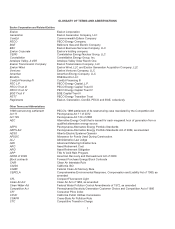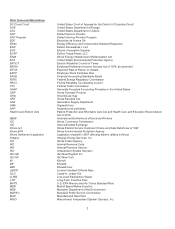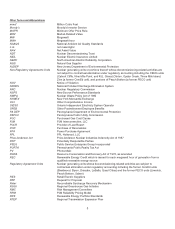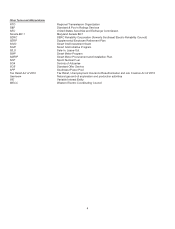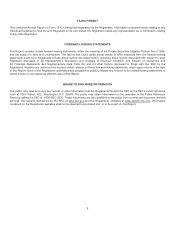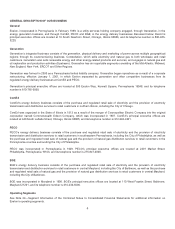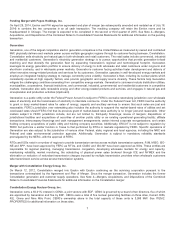Exelon 2014 Annual Report Download - page 13
Download and view the complete annual report
Please find page 13 of the 2014 Exelon annual report below. You can navigate through the pages in the report by either clicking on the pages listed below, or by using the keyword search tool below to find specific information within the annual report.Generation has six reportable segments, the Mid-Atlantic, Midwest, New England, New York, ERCOT and Other Regions,
representing the different geographical areas in which Generation’s customer-facing activities are conducted and where
Generation’s generating resources are located.
• Mid-Atlantic represents operations in the eastern half of PJM, which includes Pennsylvania, New Jersey, Maryland, Virginia,
West Virginia, Delaware, the District of Columbia and parts of North Carolina (approximately 35% of capacity).
• Midwest represents operations in the western half of PJM, which includes portions of Illinois, Indiana, Ohio, Michigan, Kentucky
and Tennessee; and the United States footprint of MISO (excluding MISO’s Southern Region), which covers all or most of North
Dakota, South Dakota, Nebraska, Minnesota, Iowa, Wisconsin, and the remaining parts of Illinois, Indiana, Michigan and Ohio
not covered by PJM; and parts of Montana, Missouri and Kentucky (approximately 38% of capacity).
• New England represents the operations within ISO-NE covering the states of Connecticut, Maine, Massachusetts, New
Hampshire, Rhode Island and Vermont (approximately 7% of capacity).
• New York represents the operations within ISO-NY, which covers the state of New York in its entirety (approximately 3% of
capacity).
• ERCOT represents operations within Electric Reliability Council of Texas, covering most of the state of Texas (approximately
11% of capacity).
• Other Regions is an aggregate of regions not considered individually significant (approximately 6% of capacity).
See Note 24—Segment Information of the Combined Notes to Consolidated Financial Statements for additional information on
revenues from external customers and revenues net of purchased power and fuel expense for each of Generation’s reportable
segments.
Nuclear Facilities
Generation has ownership interests in fourteen nuclear generating stations currently in service, consisting of 24 units with an
aggregate of 19,316 MW of capacity. Generation wholly owns all of its nuclear generating stations, except for Quad Cities
Generating Station (75% ownership), Peach Bottom Generating Station (50% ownership), and Salem Generating Station (Salem)
(42.59% ownership), which are consolidated on Exelon’s and Generation’s financial statements relative to its proportionate
ownership interest in each unit. In addition, Generation owns a 50.01% interest, collectively, in the CENG generating stations
(Calvert Cliff Nuclear Power Plant, Nine Mile Point Nuclear Station [excluding LIPA’s 18% ownership interest in Nine Mile Point Unit
2] and R.E. Ginna) which are 100% consolidated on Exelon and Generation’s financial statements as of April 1, 2014. See Note 5—
Investment in Constellation Energy Nuclear Group, LLC of the Combined Notes to Consolidated Financial Statements for additional
information.
Generation’s nuclear generating stations are all operated by Generation, with the exception of the two units at Salem, which are
operated by PSEG Nuclear, LLC (PSEG Nuclear), an indirect, wholly owned subsidiary of PSEG. In 2014, 2013, and 2012 electric
supply (in GWh) generated from the nuclear generating facilities was 67%, 57% and 53%, respectively, of Generation’s total electric
supply, which also includes fossil, hydroelectric and renewable generation and electric supply purchased for resale. The majority of
this output was dispatched to support Generation’s wholesale and retail power marketing activities. See MANAGEMENT’S
DISCUSSION AND ANALYSIS OF FINANCIAL CONDITION AND RESULTS OF OPERATIONS for further discussion of
Generation’s electric supply sources.
Nuclear Operations. Capacity factors, which are significantly affected by the number and duration of refueling and non-refueling
outages, can have a significant impact on Generation’s results of operations. As the largest generator of nuclear power in the United
States, Generation can negotiate favorable terms for the materials and services that its business requires. Generation’s operations
from its nuclear plants have historically had minimal environmental impact and the plants have a safe operating history.
During 2014 and 2013, the nuclear generating facilities operated by Generation achieved capacity factors of 94.3% and 94.1%,
respectively. The capacity factors reflect ownership percentage of stations operated by Generation and include CENG as of April 1,
2014. Generation manages its scheduled refueling outages to minimize their duration and to maintain high nuclear generating
capacity factors, resulting in a stable generation base for Generation’s wholesale and retail marketing and trading activities. During
scheduled refueling outages, Generation performs maintenance and equipment upgrades in order to minimize the occurrence of
unplanned outages and to maintain safe, reliable operations.
9




